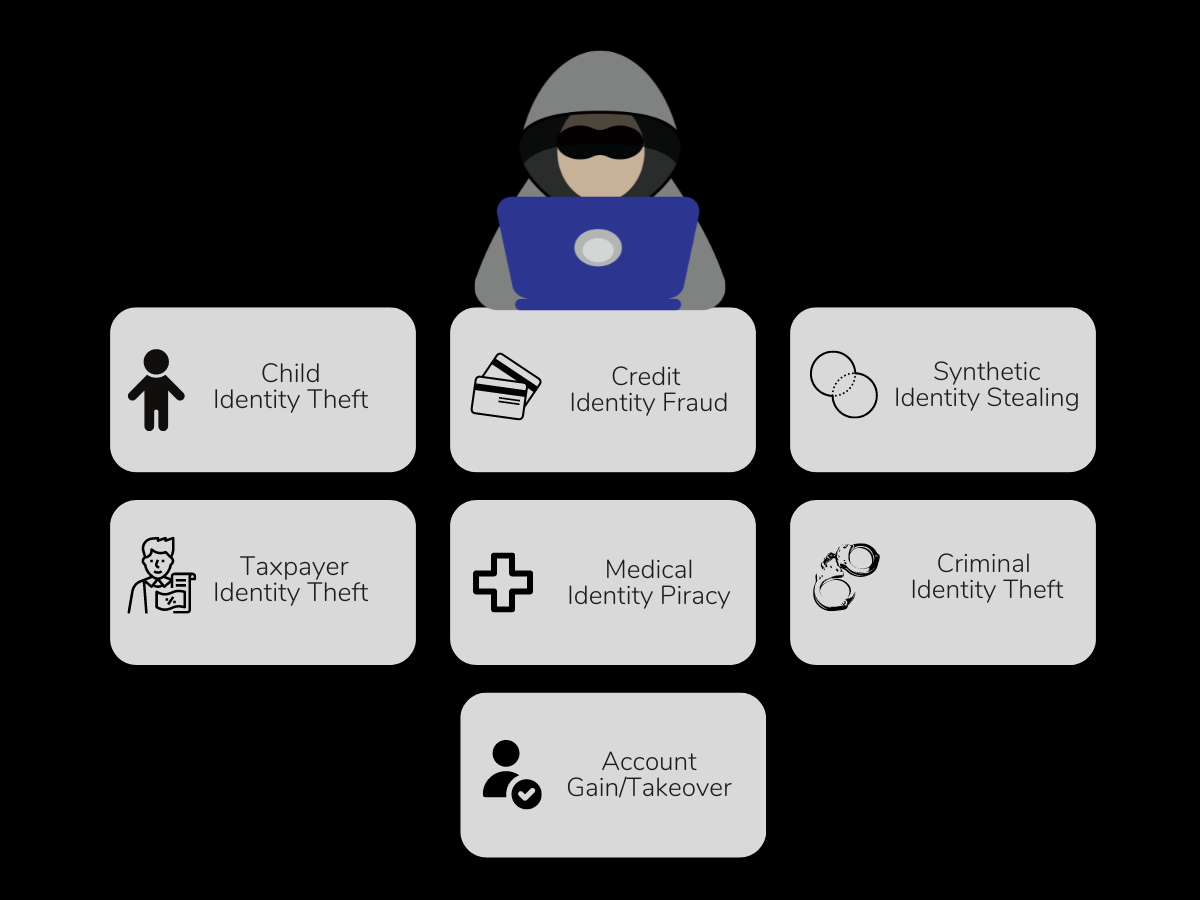Identity theft is when someone steals your personal information - know its types and how to prevent it while living in the age of technological advancement.
You would be surprised to know that identity theft ransomware has increased with technological advancement.
A report by Identity Theft Research Center (ITRC) stated a number of data compromises in the U.S. in 2021, up 68% from the year before.
This causes a growing problem in the United States. In fact, this sensitive-cause-of-act observation across the globe.
- According to the National Crime Records Bureau's Crime in India-2021 report, Bengaluru accounted for 72% of the total identity-theft cases.
- European countries are dominated by ATM-related frauds that incurred losses of more than 200 million dollars.
- According to the FTC, the number of consumer identity fraud cases rose by 3.3%, to just over 1.43 million.
Identity theft is a serious notion to discuss on a global as well as national agenda. It occurs when someone (unknown or known person) steals or uses your personal data such as your name, Social Security number, birth date, etc. - to harm you, typically in the form of financial loss, opening a new credit statement, draining your bank, and so on.
Today we’ll learn about identity theft (identity fraud), its major types, and top prevention tips including spot warning signs and taking quick actions to save yourself.
What Do You Mean By Identity Theft?
Identity theft is a term used when someone is being blitzed and targeted using his/her personal information (digital and paper) without their permission, to commit fraud or other crimes - typically for economic gain. It is also observed as identity fraud, identity stealing, incognito, and phishing.
In most cases, it is executed by a close member of the affected person or a long-relative member. Identity thieves could do from standard breaches of attacks to brutal causes. They may drain your bank funds, open new credit lines, get utility services, take your tax funds, and a lot more.
In addition to this, since they have your information, they could attack multiple times. As soon as you realize the breach, try to inform the locals and your bank.
Also Read: Cybersecurity: Why It is a Future?
How To Examine And Report Identity Theft?
Examining starts when you encounter any of the identity theft types. First, look into the matter, cause, and loss you incurred with. Rectify and be confidently sure about the breach you bind with.
To report, you can use an online medium (fast and quick) or offline medium such as contacting your police department, the postal services, or the credit bureaus, accordingly.
You can report your phishing to Identitytheft.gov which is a one-stop platform for reporting and getting recovery steps about identity thefts.
It is run by the Federal Trade Commission and is thereby trusted. Report your happening, and follow the recommended steps to make a recovery plan.
7 Critical Types Of Identity Theft (With Warning Signs!)
Once the intruder has your information, it can be exploited in many ways. Following are top seven critical identity fraud practices to be seen in these days.

1. Child Identity Theft
It’s a common practice by criminals when they entail your child’s personal information. Criminals obtain such information through tricks and apply for credit in that child’s name. Although it could not ironically be discovered until the victims appear for college loans or other credit.
Warning signs: In the event your child is getting phone calls or being asked by some medium about late payments or debt collections, investigate. You can freeze your child’s credit card to prevent it.
2. Credit Identity Fraud
It is the most frequent identity theft practice by malefactors.
In this they use your personal information and Social Security Number, to apply for a new credit line. On the other hand, withdraw funds from your credit account, using psychological tricks.
Warning signs: Unusual happening, for instance, the unexpected change in your credit score or an account you don’t resemble on your credit account. Receiving a court judgment against you. The best way to prevent it is simply to freeze your credit and report an FIR.
3. Synthetic Identity Stealing
It’s a case-sensitive identity-stealing practice that could not only harm an individual but also entities. Synthetic Identity Theft (SIT) or Synthetic Identity Fraud (SIF) is a combination of an individual's identifiable information to fabricate similar entities with the intention to commit a bad act.
A criminal uses synthetic identity fraud to credit repair, apply for employment or services, and obtain goods, cash or services with no intent to repay.
Warning signs: Identifying the cautions of this scenario is a bit complicated. Paying for purchases that you never did or a person working on the behalf of your identity could be examples of this.
4. Taxpayer Identity Theft
An outlaw who intends to steal a tax refund or tax credit is observed under this vulgarity act. It happens when they steal or trickly figure out your Social Security Number to file a tax return and steal your tax refund.
Warning signs: You may not be able to file your tax return because it has already been done. Filing early can help you avoid getting caught in this testimony.
5. Medical Identity Piracy
Using synthetic identity theft practices to get health care services or claim a health benefit is medical identity fraud. This kind of impropriety is dangerous because it can result in medical histories being mixed, resulting in providing wrong information to doctors and hospitals.
Warning signs: Claims and health insurance principal payments that you won’t recognize can help your intellect that someone is using your health care identity.
6. Criminal Identity Theft
Criminal identity fraud occurs when a savage person provides legal authorities or trooper someone else’s personal information such as phone number and address during custody or investigation.
Warning signs: Getting calls from police officials for reasons that are unclear to you, or your promotion denied due to something violation found in a background check.
7. Account Gain/Takeover
Bank provides users with banking IDs with a password for a seamless banking experience at their fingertips. And they advised you not to share with anyone. It is because it could lead to severe financial loss.
Criminals that use personal data to access your financial accounts and change your credentials for the purpose of account takeover and - leave you with financial loss.
Warning signs: An email or letter from the bank telling you that your password or email changed or even a transaction that you don’t recognize.
Also Read: What Are Social Engineering Attacks? Its Types & Examples
9 Best Identity Theft Prevention Methods
There are many post-prevention steps a victim may use. But the most important discussion is how you should keep yourself safe and not be caught with any type of identity theft before it may happen to you.
I’ve mentioned some popular identity theft prevention steps which could help you secure your data from stealing.
Safeguarding your SSN: If you pay taxes or provide public assistance, you would know how important Social Security Number is. Guard it as best you can. Don’t carry your card and if possible securely store or shred your SSN.
Use strong passwords: Banks and other entities often advise you about using strong passwords. Strong passwords are a combination of upper and lower case letters, numbers and symbols, and are ten or more characters in total.
Add an authentication step: Still many people rely on old authentication security layers. For instance; questions, such as your mother’s maiden name or pet’s name, are not hard to crack. Use authenticator apps that provide security features at their best.
Use alerts: Transactions made to merchants or to any third party or transferring payment from one bank to another bank account, the bank provides alerts to your mobile number as well as an email address. Ask your institution to enable such a facility on your bank account.
Use a digital wallet: There are many of them in the app store. Instead of using bank applications or internet banking, use a digital wallet for money transfers and payments as it is additionally secured and helps you fast the payment process.
Protect your mobile device: Since many people rely on smartphones and conveniently use them to find something online, it is important to protect your device against any miscellaneous activities. Use a banking app rather than a mobile browser for banking.
Monitor credit reports regularly: If you have a credit card and mostly use it for various things, glimpse credit statements, reports, and transactions regularly to be sure everything is up to mark.
Monitor medical statements: Financial and medical aspects are the hacker’s blindspot target for hunting. Be sure you frequently check and monitor your medical statements. Make sure you recognize every transaction.
Deny picking up phishing calls: Reportedly, scammers steal personal information from users through the practice of phone calls that appear to come from government or business. Importantly, they ask for OTP and other personal information. Deny the calls immediately if it seems illegitimate to you.
What To Do After Identity Theft Occurred?
It could happen to anyone. Generally, having a weak password or being too friendly with strangers, and browsing without security are the ones who are quickly engrossed in the identity theft phenomenon.
First thing… don’t panic…! And follow the mentioned steps to protect yourself.
- File a claim with your identity theft insurance.
- Notify respected companies of your stolen identity.
- Draft a case with the Federal Trade Commission.
- Aware the local police department about this.
- Raise a fraud alert on your credit report.
- Immediately freeze your credit.
- Tighten or change passwords on your accounts.
- Review your credit report for any mystery details.
- Invest in identity theft protection service.
Do You Need To Invest In The Best Identity Theft Protection Service?
Identity theft protection service plays an important role in this scenario. Generally, these services monitor the activities that you have incurred on various websites and databases related to personal information, such as your social security, driver's license number, medical ID and bank account numbers.
Its benefits are helpful for companies and their associates. For instance; preventing employees from becoming disengaged while dealing with any miscellaneous practice of identity theft.
You can look into inviting some of the best ID protection solutions in case of protecting identity theft praxis. They could provide credit monitoring, identity monitoring, identity restoration feature, and identity theft insurance. LifeLock, McAfee Identity Theft Protection, and IDShield are some good identity theft practices.
Also Read: What is Digital Identity Management?
Conclusion
Consider using identity theft protection services to know about the data breach and identity theft happening at first. If you have been a victim of identity fraud, they could also guide and provide you with steps to clean the mess and reinstate your identity theft.
Each ID protection solution offers critical and common features to the users, but there might be a difference in pricing. Choose the best identity theft protection services kindly.
Frequently Asked Questions
Is identity theft dangerous?
Yes, identity theft or identity fraud is a crime and its impact could be severe. It is because it involves the practice of causing victims serious fear, worry, and stress.
How is identity theft investigated?
Though all the identity thefts are crimes and there is a legal penalty for that, such instances carried systematic investigation procedures. Law enforcement accepts the complaint, prepares a police report and marks instances/complaints with a copy, and initiates the investigation process.
What are the consequences of identity theft?
Consequences for the victims of identity theft could be brutal. Intruders can open new credit cards or loans in your name. They could even change your email passwords and account takeover. Perhaps, you can lose your health care benefits.
What are the examples of identity theft?
False civil and criminal judgment, stolen phone, social security number misuse, stolen checks, etc are some popular examples of identity frauds.
What are good ways to protect yourself from identity theft?
Early steps could help protect you from getting caught for identity theft. Those are securing your mobile device by locking functions, avoiding sharing personal information to anyone (especially calls from fraud persons or businesses), using digital wallets, and monitoring credit cards regularly.
What are the first signs of identity theft?
Unrecognized charges or withdrawal, new credit cards that you didn’t know about, collection notice or calls for unknown debt are the first signs of identity theft.
Can passport numbers be used for identity theft?
No, it is not possible for hackers to execute identity theft practice just with a passport number. Other important databases are needed such as the victim's full name, birthday, and nationality.

